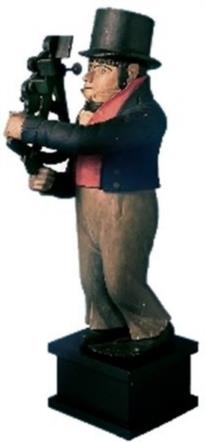
NavList:
A Community Devoted to the Preservation and Practice of Celestial Navigation and Other Methods of Traditional Wayfinding
From: Frank Reed
Date: 2022 Jul 9, 18:47 -0700
Ron Hansen, you wrote:
"As a left handed person, I never realized how convenient the standard right handed configuration is for noting down observations until I read your post."
Yes, it's clear that the standard design of the modern marine sextant is better suited to left-handed navigators. Five years ago, Paul Saffo previously mentioned this same Coutinho sextant and wondered about its handedness. I answered back then "If it's backwards then it's a right-handed sextant. The normal sextant is clearly designed for a left-handed user. At some point in the 19th century, via spontaneous symmetry breaking, the standard design became frozen with the minority chirality. It's the revenge of the southpaw navigator!"
Early double-reflecting instruments, and common wooden octants especially, frequently did not have handles so there was really no "handed-ness" to them. It's true that the mirrors and the index arm were usually on the side that we consider "normal" today, but a navigator would hold the instrument by the frame (there's artwork from the era confirming this, like the statuette in the image). You could use either hand to complete the fine adjustment and then record the result. As handles became more common, the instrument design broke the symmetry and became preferentially suited to left-handed navigators. There's no evidence anyone planned it this way. It appears to have been a historical accident. Although manufacturers have attempted to sell mirror image sextants over the years, they don't do well in the market. Navigators are a conservative lot by nature, and they don't like innovation or difference. Also, navigators frequently acquire sextants before they know much about celestial navigation. It's a "buy first, ask questions later" sort of thing. So despite the fact that most navigators, like most people, are right-handed, marine sextants will probably remain "leftie" forever.
I can imagine one technological development finally ending the tyranny of the standard "leftie" sextant. In the early days of sextants and similar instruments, a navigator would commission or request a sextant from an artisan who could add features on request. Each instrument was unique. We are approaching an era when a sextant might once again be produced on-demand with custom features thanks to 3D printing. If you have a digital sextant design to feed into some sort of 3D printing system, it's trivial to flip the whole thing and make a mirrored sextant. The bespoke, tailor-made sextant could make a comeback right at the end of the era for these instruments.
Frank Reed







